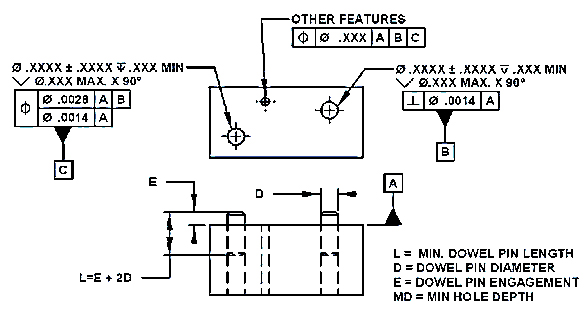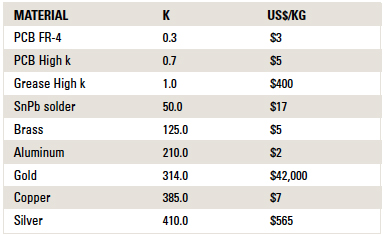Does a tighter tolerance guarantee superior quality and better function, or just a higher unit cost?
Whether designing, building, selling or buying a product, all of us believe we are striving for the best possible quality. After all, who would want to be associated with a mediocre or shabby commodity? But does a tighter tolerance guarantee superior quality and better function, or just a higher unit cost and fewer bidders? Let’s dig a bit deeper and determine if a better understanding could guide our choices and yield improved cost-performance.
Take a simple interference fit application. Consider an engineer drafting the requirement for a small locating shaft that would be press-fitted into a receptor formed by a circuit board or enclosure (FIGURE 1). Once used to locate other components, it would cease having a function. How best to set the tolerance of the two mating parts?

Figure 1. A drawing of a pin fit interconnect.
The tolerance of a pulled steel pin varies with its diameter, with a 0.032" pin having a tolerance of 0.0005", while a larger pin diameter 0.320" would have a standard tolerance of +/-0.0025", a five times greater variation. The tolerance of the drilled receptor also varies with the hole size. For FR-4 substrates and standard machined metal receptors, the hole tolerance is +/-0.003" for a hole 0.032" in diameter, increasing to +/-0.006" for 0.320" diameter holes. Assuming a nominal 0.100" situation, the interference or a gap could be 0.004". When the hole is smallest and the pin largest could the pin be forced into the small hole? Would the pin fall out when the hole is at the large extreme and the pin at the smallest? Both failures would cost in production.
A typical dowel pin, however, is machined more precisely and could be made to a tolerance of +/-0.0002". Yes, more precise and permitting a more controlled fit – but at what cost? And of what benefit unless you were also to pay for a tight-tolerance hole? Would the solution be to pay the price or to accept less precision in exchange for greater economics? Perhaps a third option would be preferred.
One solution would be to assume the hole at its largest, use a lead-in on the pin and to apply riveting compression to swedge the pin larger to fit the hole. A very tight tolerance would not be required, permitting more vendors to bid, all aiming for a lower target. Another option is a slotted spring or roll pin that would compress when squeezed into the hole. Example: A nominal 3.5mm (0.138") roll pin would compress to fit a hole only 3.4mm (0.134") in diameter. A design using such a lower tolerance part does the same job at a significantly lower cost for both the pin and receptor.
A second example of lower precision for lower cost but not yielding lower quality could be found in plastic electronics enclosure snap fits (FIGURE 2). We think of a snap fit as being tight, but in practice the objective is for the deformation to relax after engagement, thus relieving the stress on the component. Over time any residual stress would cause strain in the connector, which often manifests itself in premature failure.

Figure 2. A snap fit might cut costs and improve reliability.
A typical case would be a snap fit designed into a homopolymer housing like polycarbonate. Residual stress will often lead to brittle failure, so the part must be carefully designed, molded, sometimes post-treated, and attention must be paid to maintaining tolerances. These tight controls mean higher component costs and still contain the specter of field failures. A change in the polymer specified, for example, to a blend of polycarbonate and ABS, reduces the chance of brittle failure, and at the same time reduces the resin cost. This is another example of an economical workaround, passing on the concept of tight tolerance meaning “higher quality” and going for better performance at a lower cost.
In a third case we cast a wary eye on what seems to be a critical property but on closer investigation is more a tempest in a teapot. MCPCBs (metal core printed circuit boards) are being used in increasing numbers. Applications include voltage regulators, thermal printers, high output amplifiers, high power ICs and temperature-sensitive oscillators, and the exploding market for high-intensity LED systems. Engineers faced with a need to control heat transfer might be swayed by the singular property, the thermal conductivity (k) of the core substrate.
A review of a material property chart (TABLE 1) would show that the range of thermal conductivity is large among metals, and so is the price. Silver is a great heat conductor but its cost makes one search for alternatives. Copper also is a good performer, but its cost coupled by its density limits use to extraordinary applications. The selection of the thermally conductive metal layer commonly falls to aluminum as a good combination of cost/performance/processability. However, within the realm of aluminum there are many alloys with differing conductivities and prices. Which would yield the highest quality/best performance for the dollar spent? Could relaxing a tolerance in the conductivity spec give acceptable performance at a significant cost savings?
Table 1. Relationship of Metal Thermal Conductivity and Prices

First, consider that in this case the metal substrate chosen is only one part of the composite PCB structure. Since the electrical insulating layer is the most thermally resistive, and that electrical insulation is required, variations in the relatively high k layer might mean minimal changes in the overall thermal conductivity. Tests have shown that aluminum MCPCB structures might vary in thermal conductivity by +/-2 W/(m·K) and vary in price by a factor of 400%, yet in actual use demonstrate little difference.
In a case like this, the design engineer and purchasing department work best as a team. The engineer calculates a probable scenario and addresses the areas of concern with potential solutions. Purchasing then prices the entire system and highlights those design aspects that restrict bidders and drive up cost. After discussion with the engineers the buyer returns to the market, contacting the vendors seeking suggestions for cost savings. These options are prioritized based on cost, and engineering selects among them based on acceptable performance.
In these analyses might the final solutions yield less than the ultimate performance? Probably so, but if it is acceptable in the end-use, and if it adds an advantage in a cost-sensitive market, then the team would have a winner. The best solution usually is not the tightest tolerance or even the best performance – it is what yields the most marketable end-product.
Robert Simon is a veteran of technology development and marketing, having worked R&D and marketing for electronics, polymer, and metal companies, including Bayer AG of Leverkusen Germany and Battelle Memorial Institute of Columbus, Ohio, before founding USTEK Inc.; This email address is being protected from spambots. You need JavaScript enabled to view it..
















